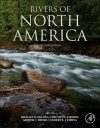This group of authors includes most of the leading experts in the ecology of North American rivers. They have provided a starting point for investigating our rivers and given us the tools for understanding how our rivers function. Now it is time for us to get to work! -David R. Lenat, Raleigh, North Carolina, JOURNAL OF NORTH AMERICAN BENTHOLOGICAL SOCIETY "Clearly a massive undertaking, the work consolidates facts about individual rivers, from geomorphology, hydrology, and water chemistry to biodiversity and ecology...The book's foreword was written by Robert F. Kennedy Jr. in his capacity as president of the Waterkeeper Alliance, an environmental organization focused on protecting rivers. As he says about the book, 'you will find a few remaining pristine rivers that deserve conservation as benchmark systems.' On the other hand, he notes that a reader will also find that some North American rivers 'have major problems...for which radical and immediate CPR is required.' The book indeed has details about the environmental good and bad for virtually all the continent's major rivers. Art Benke and Bert Cushing have produced a monumental work that will serve as a basic comparative reference for many years. The book is also useful for people who want to reminisce about their favorite rivers." - Whit Gibbons, in AIKEN STANDARD "...the first comprehensive effort to detail the current state of the continents rivers. This marvelous resource began as a coffee-table book. Four years later, ambitiously expanded, it covers more than 200 rivers, from southern Mexico to the Arctic. Its 22 chapters, written by scientists and hydrologists, discuss specific basins or regions such as the Colorado River Basin and the Pacific Coast rivers of Canada and Alaska. Rivers describes the physiography, geomorphology, hydrology, biodiversity and ecology of each system, in addition to detailing human impacts and special features. Winner of a 2005 Award for Excellence in Projects and Scholarly Publishing by the Association of American Publishers and a Library Journal Best Reference Work citation, this large-format, full-color volume contains copious maps and illustrations...The well-organized book conveys the 'bewildering heritage' of the continents rivers and examines contemporary challenges." - Irene Wanner for HIGH COUNTRY NEWS "This unique and beautifully illustrated volume fills a gap in the reference literature of conservation biology, geography, geology, ecology, and hydrology by providing information on more than two hundred rivers...A particularly valuable and attractive feature of the book is its detailed maps of each river system, created from data held in the major cartographic datasets of the US Geological Survey, Canada's GeoGratis, and Mexico's Hydrolk Elevation Derivative Database...this book should be acquired by all public library systems, museum libraries, regional historical societies and special collections, corporate libraries in firms involved with river management, and college and university libraries supporting undergraduate and graduate programs in biology, conservation ecology, hydrology, geography, geology and agriculture." - Robert Ridinger, Electronic Information Resources Management, Northern Illinois University, for E-STREAMS "This outstanding reference comprehensively evaluates the status of over 200 major North American river systems from southern Mexico to the Arctic...Each chapter has the same format, which allows readers to compare a river's physical, biological, hydrological, and ecological characteristics with those in other regions. All chapters contain an introduction describing basin landscape, physiographic and climatic attributes; a one page summary on up to 12 rivers, including a basin map and graphs of mean monthly temperature, precipitation, and runoff; and expanded text, augmented by color photographs, for up to five 'focus' rivers per chapter...Of special value is the detailed information provided in the one-page river summaries...Each page summary lists major information sources and literature cited. Color photographs of representative river systems that accompany each chapter vividly illustrate the diversity of rivers on the continent. This book contains an enormous amount of excellent information that is not available from any other single source. It should become a standard reference on North American rivers. Scientists, conservationists, politicians, students, and the general public will use this work extensively. This high-quality publication is a new source of knowledge about a most valuable natural resource...Summing up: Essential. All libraries; all levels." - M. J. Zwolinski, University of Arizona, in CHOICE "Rivers shape and are shaped by many aspects of the natural world and human experience. Rivers of North America reflects that reality, blending the physical, social, and life sciences to create an encyclopedic resource for anyone who loves rivers or wishes to learn about them... Well structured, clearly written, and beautifully illustrated with photos and maps, Rivers of North America will provide many hours of exploration and discovery. Hydrologists and water managers will benefit from a greater appreciation of rivers ecological values, and understanding of the links between hydrology and ecology. Five more continents with rivers remain; sequels will be eagerly anticipated. "The time and care invested are evident. The 22 chapters on river systems, each written by a different set of authors, are consistent not only in their structure, but also in their style. This is a remarkable accomplishment...Well structured, clearly written, and beautifully illustrated with photos and maps, Rivers of North America will provide many hours of exploration and discovery. Hydrologists and water managers will benefit from a greater appreciation of rivers' ecological values, and understanding of the links between hydrology and ecology. Five more continents with rivers remain; sequels will be eagerly anticipated." - Kaye L. Brubaker, Civil and Environmental Engineering, University of Maryland, College Park "...an excellent compendium, the first comprehensive treatment of North American rivers...The cross-disciplinary range of each river's information (e.g., early human habitation to water-quality data) is impressive. I especially liked the inclusion of historical impacts that still affect rivers...Given the wide range of information, ease of use, and paucity of other sources, I recommend Rivers of North America as a valuable reference book that will certainly interest biologists, environmental scientists, and conservation biologists working with freshwaters. Government and industrial water managers, and nongovernmental organizations dealing with water issues would also benefit from consulting this book...it would be a valuable tool in teaching a variety of freshwater-related courses." - Elizabeth A. Bergey, University of Oklahoma, for LIMNOLOGY AND OCEANOGRAPHY BULLETIN "This comprehensive synthesis provides the first interdisciplinary perspective on the regional characteristics of rivers and associated ecosystems...This treatise will be an invaluable reference and benchmark for biologists, hydrologists, planners, and policy makers for many years to come." - Alan P. Covich, Professor and Director, Institute of Ecology, University of Georgia "Grand in design and even grander in scope and execution, Rivers of North America will shape our collective thinking about North American rivers and watersheds. Here is an indispensable guide to the geography, ecology, and status, including pressures from human actions, of rivers from the Canadian Arctic to Mexico. Superb graphics and stunning photographs enrich the books wealth of scientific detail." - James R. Karr, Professor, University of Washington, Seattle "Rivers of North America is a landmark contribution to the scientific study of flowing waters in North America. It is both authoritative and comprehensive, and could be as useful on a cross-country trip as in a personal library for reading and reference." - William M. Lewis, University of Colorado, Boulder "This book is astonishingly encyclopedic in scope and condenses the wisdom and insight of regional experts into readable syntheses and informative one-page fact sheets for North America's rivers. It is an entryway to further scientific information on over 200 individual rivers and will be an invaluable resource for professionals as well as concerned citizen groups." - Judy L. Meyer, Distinguished Research Professor of Ecology, University of Georgia "Rivers of North America is an extremely valuable volume on our major continental rivers...Clearly, this is a volume that all devotees of rivers--scientists, resource managers, anglers, boaters, and the lay reader--definitely will want to own." - Kenneth W. Cummins, Co-Director, Institute for River Ecosystems, Humboldt State University, Arcata, California This volume is a must for rivers scientists, conservationists, paddlers, river recreationists, sports fishermen--for anyone and everyone concerned about the future of the continents most valuable natural resource. It should be the standard reference on North American rivers for a long time to come. - Robert F. Kennedy, Jr., President, Waterkeeper Alliance, from the Foreword "I have just had the opportunity to examine the pre-publication version containing the first 15 chapters of Rivers of North America. I was blown away by its thoroughness, logical and consistent organization, overall eye appeal, and sheer size. This is truly an outstanding book, especially for one so loaded with factual information! This is the first comprehensive coverage of the rivers of North America and is unique in its ecological focus. Not only that but it also is masterful in its content and design. The individual chapters, on specific regions, are chock full of facts and contain abundant references to additional information. They also are copiously illustrated, mostly in color, including a full-page photograph of a representative river and a locator map of each river covered. I was especially impressed with the single-page synopses of individual rivers at the end of each chapter, containing thumbnail descriptions of physical and biological features; graphs of monthly temperature, precipitation, and runoff; and a color topographic map of each basin. In summary, this is an outstanding reference source and essential guide to what is and what is not known of the principal rivers on this continent. Anyone interested in rivers and their conservation will want to have a copy within easy reach." -Wayne Minshall, Professor Emeritus, Idaho State University


































